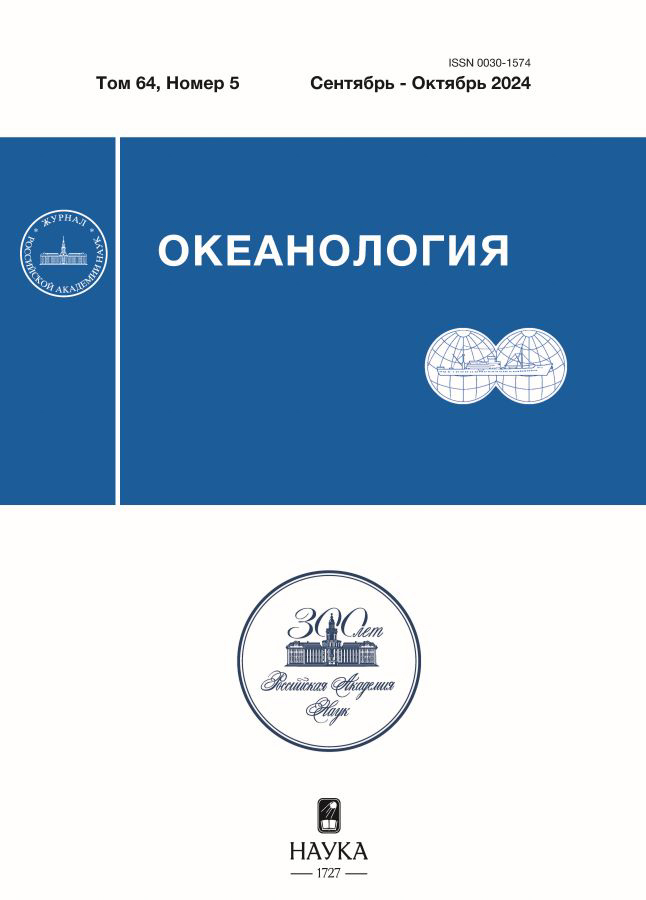Study of the PDO index predictability for 1 to 5 years with INMCM5
- Авторлар: Aleksandrov M.S.1, Volodin E.M.2, Vorobyeva V.V.2
-
Мекемелер:
- Lomonosov Moscow State University
- Marchuk Institute of Numerical Mathematics of the Russian Academy of Sciences
- Шығарылым: Том 64, № 5 (2024)
- Беттер: 833-840
- Бөлім: Instruments and methods
- URL: https://journals.eco-vector.com/0030-1574/article/view/681402
- DOI: https://doi.org/10.31857/S0030157424050089
- EDN: https://elibrary.ru/OFNCHV
- ID: 681402
Дәйексөз келтіру
Аннотация
The Pacific Decadal Oscillation (PDO) index has been calculated using the INMCM5 climate model developed by the Marchuk Institute of Numerical Mathematics, Russian Academy of Sciences. The PDO index correlation with the reanalysis data decreases from about 1.0 in November of the starting year to 0.355 in October of the following year. The model forecast for the PDO index is reliable for the first 2 years, but correlation coefficients decline significantly after that. The inertial forecast is more accurate in the first 2 years and becomes less reliable onward. The correlation coefficient for the model ensemble forecast of the PDO index with its components in the ensemble is greater than the correlation between the ensemble average and the actual PDO index. The INMCM5 climate model is suggested to have potential for considerable improvement in forecasting the PDO.
Толық мәтін
Авторлар туралы
M. Aleksandrov
Lomonosov Moscow State University
Хат алмасуға жауапты Автор.
Email: aleksandrovms@my.msu.ru
Ресей, Moscow
E. Volodin
Marchuk Institute of Numerical Mathematics of the Russian Academy of Sciences
Email: volodinev@gmail.com
Ресей
V. Vorobyeva
Marchuk Institute of Numerical Mathematics of the Russian Academy of Sciences
Email: VVorobyeva@yandex.ru
Ресей
Әдебиет тізімі
- Володин Е.М. Воспроизведение современного климата моделью климатической системы INMCM60 // Известия РАН. Физика атмосферы и океана. 2023. T. 59. № 1. С. 19–26.
- Воробьева В.В., Володин Е.М. Экспериментальные исследования сезонной предсказуемости погоды, выполненные на основе климатической модели ИВМ РАН // Матем. моделирование. 2020. Т. 32. № 11. С. 47–58.
- Blagodatskikh D. Comparison of computational efficiency of two versions of a terrain-following ocean climate model // Numerical methods and programming. 2023. V. 24. № 4. P. 440–449.
- Blagodatskikh D., Iakovlev N., Volodin E., Gritsun A. Non-local discretization of the isoneutral diffusion operator in a terrain-following climate ocean model // Russian Journal of Numerical Analysis and Mathematical Modelling. 2023. V. 38. № 6. P. 353–360.
- Bock L., Lauer A., Schlund M. et al. Quantifying progress across different CMIP phases with the ESMValTool // Journal of Geophysical Research: Atmospheres. 2020. V. 125. № 21. P. e2019JD032321.
- Boer G.J., Smith D.M., Cassou C. et al. The Decadal Climate Prediction Project (DCPP) contribution to CMIP6 // Geosci. Model Dev. 2016. V. 9. № 10. P. 3751–3777.
- Carton J.A., Chepurin G.A., Chen L. SODA3: A new ocean climate reanalysis // J. Clim. 2018. V. 31. № 17. P. 6967–6983.
- Dee D.P., Uppala S.M., Simmons A.J. et al. The ERA-Interim reanalysis: configuration and performance of the data assimilation system // Q.J.R. Meteorol. Soc. 2011. V. 137. № 656. P. 553–597.
- Deser C., Alexande M., Xie S., Phillips A. Sea surface temperature variability: patterns and mechanisms // Annual review of marine science. 2010. V. 2. P. 115–143.
- Eyring V., Bony S., Meehl G.A. et al. Overview of the Coupled Model Intercomparison Project Phase 6 (CMIP6) experimental design and organization // Geosci. Model Dev. 2016. V. 9. № 5. P. 1937–1958.
- Hersbach H., Bell B., Berrisford P., Hirahara S. The ERA5 global reanalysis // Q.J.R. Meteorol. Soc. 2020. V. 146. № 730. P. 1999–2049.
- Mantua N., Hare S., Zhang Y. et al. A Pacific Interdecadal Climate Oscillation with impacts on salmon production // Bull. Am. Meteorol. Soc. 1997. V. 78. № 6. P. 1069–1080.
- Meehl G., Goddard L., Murphy J. et al. Decadal prediction: can it be skillful? // Bull. Am. Meteorol. Soc. 2009. V. 90. № 10. P. 1467–1485.
- O’Neill B., Tebaldi C., Vuuren D. et al. The Scenario Model Intercomparison Project (ScenarioMIP) for CMIP6 // Geoscientific Model Development Discussions. 2016. V. 9. № 9. P. 3461–3482.
- Taylor K.E., Stouffer R.J., Meehl G.A. An Overview of CMIP5 and the experiment design // Bull. Am. Meteorol. Soc. 2012. V. 93. № 4. P. 485–498.
- Volodin E.M., Mortikov E.V., Kostrykin S.V. et al. Simulation of the present day climate with the climate model INMCM5 // Clim. Dyn. 2017. V. 49. № 11. P. 3715–3734.
Қосымша файлдар















